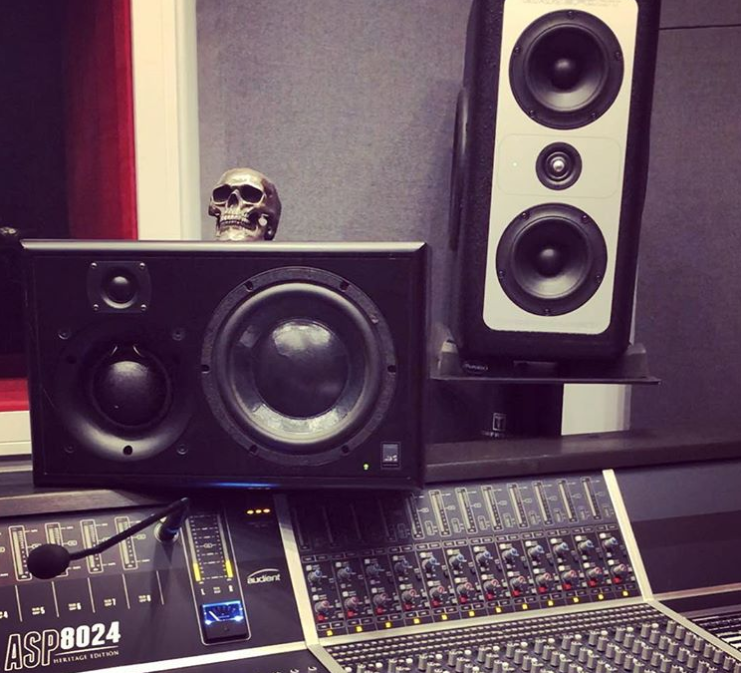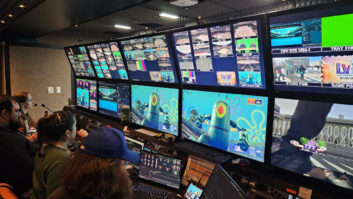
Located just outside of Mansfield, 40 minutes from the centre of Sheffield in the north of England, out of the way in a small village in the countryside lies an old deconsecrated Methodist Church.
Inside however, is not what you would expect. No alter, no pews and no pulpits. Instead, the century-plus old building has been converted into a state of the art recording studio capable of housing up to 10 rock musicians at once – a shot in the eye to those that once condemned rock ‘n’ roll as the ‘devil’s music.’
As you could imagine, converting the venue over the past 18 months or so was not without its challenges due – primarily – to its high ceilings and architectural design creating a potential acoustical nightmare – not ideal for a musicians wanting to produce music to the highest audio quality and paying up to £130 per day.

Musician, engineer and producer, Oliver Kenny (pictured) oversaw the project, from choosing and bidding on the building at auction, to spending months on the overall design, overseeing the acoustic setup and painstakingly costing the specifications.
“The initial brief was to find a building that could be a blank canvas with high ceilings so I could craft a studio space with minimal limitations,” explained Kenny, talking of his studio’s evolution. “Somewhere down the line I started looking at church properties and began to think it was a viable option. I found this one listed at auction; having previously bid on around 10 churches, all silent bids, this one was at an actual property auction and was the most nerve-wracking experience of my life!”
He continued: “The main church structure, on entry, was around 8-9m from floor to ceiling, which allowed me plenty of room to have high ceilings downstairs (around 4m) but also have room upstairs to live and function properly. I had a company come in and fit 14 steel pillars to support a steel and concrete floor, which split the building into the ‘house’ upstairs and studio downstairs.”

The tech
Kenny, who lives on sight (his room located where the old alter was once positioned), created two studios; Studio A and Studio B.
Selecting the right equipment he explained was crucial to ensure both quality but also appeal for current and budding musicians.
The tech chosen for Studio A (Studio B not yet complete) includes 36-channel ASP8024 Heritage Edition – an analogue recording console from Audient, supplied by Recording studio experts, KMR Audio.
Full equipment list can be found here
“I took pride in putting together an equipment list that is the best value for money, having balance throughout my chain, compromise where needed and quality where it counts resulting in a great finished sound,” said Kenny. “This balanced approach allows me to create a world-class sound for my clients – without breaking the bank for either of us.”
Skip forward a year and Kenny moved into his newly completed house-within-a-church in March, which he describes as “a permanent forever home that I can grow into with a family.”

The opening of Studio A went, as he described “without a hitch”, with Kenny inviting local band ‘The Family’ to come and trial the space, and record demos of two of their songs.
“They were so impressed with the space and the gear, that they have booked in to record their debut album later in the year.”
Discussing the Audient console, he added: “The desk’s sound quality is able to compete with desks at a much, much higher price point, its functionality is flexible and the module design of the desks allowed me to design my version of the console with space for the Slate MTI2 in the middle for automation.” With 36 channels, two producer bays and a patchbay, the setup suits Ol’s workflow perfectly. “I love an inline console design. You can essentially get a recording level and mix at the same time so, so easily.
“I think one thing that has surprised me is just how much I have come to love the Retro Iron, High Lift and Low Bump buttons on the stereo bus. During mixing, these are pressed down almost the entire time. It just adds something to the sound that is so subtle but when you take it off you’re painfully aware of that, to use a cliché term, ‘vintage coloured type tone’ being missing.

“Although we also have some vintage console mic pre clones that we use on some of the core sounds, a lot of the time for everything else we will use the pre’s from the desk. The amazing quality of sound that they produce means they can sit alongside the classics and you can’t go wrong.”
As mentioned, Studio B – a smaller studio/producer space – is still under construction, but Kenny insists there won’t be any compromise in the quality. “We thought very carefully about the relationship between Studio A and B and how these could complement each other. We have the Audient iD22 as our audio interface in addition to the ASP800 8-channel mic pre, so that we are able to record a full 10 channels of audio at once to record a full drum kit easily.
“What was super important to me in the design of the studio rooms was flexibility. I needed to make sure that Studio B had a similar spec to Studio A, so any overdubs or any vocal or instrument work in Studio B don’t sound different to Studio A. Having the same class-A mic pres throughout the Audient range, and fantastic converters in the iD22, means I have no doubt that whatever we do across the two different studio rooms for tracking, will result in no noticeable difference in quality.”
He concluded: “The studio is designed to work with bands with big guitars, loud drums, screaming vocals and a heavy sound. We could of course record anything but those are the kind of sounds and genres our space specialises in as this is what we love to do ourselves.”
It’s a good job he’s the only neighbour.







